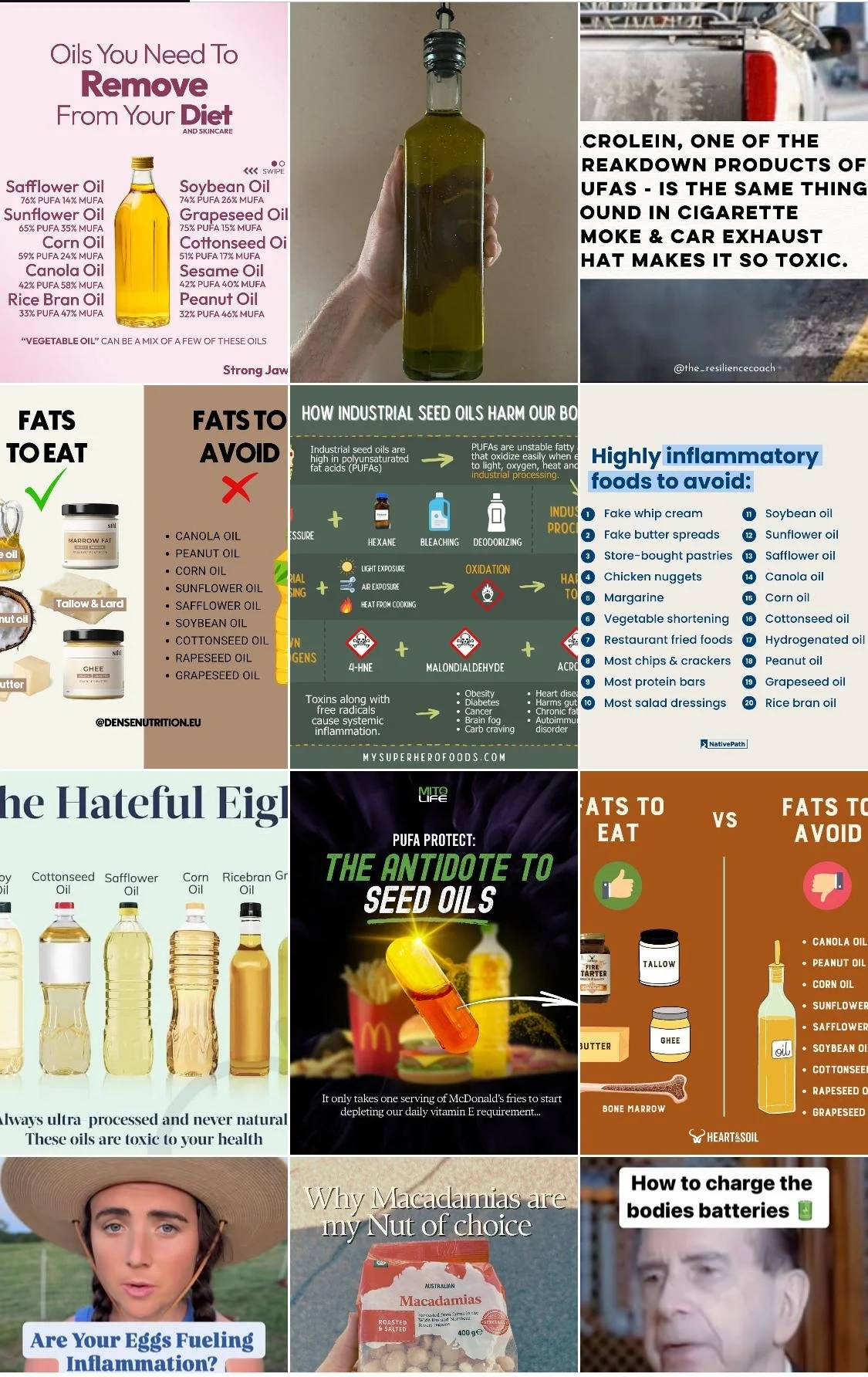Are PUFAs good or bad for you?
Scroll down any health-focused social media feed today and you'll encounter a bewildering array of conflicting advice about PUFAs (polyunsaturated fatty acids). One expert tells you to avoid all vegetable oils like the plague, while another promotes them as heart-healthy essentials. Meanwhile, confused consumers stand in grocery aisles wondering whether that bottle of canola oil is a nutritional hero or villain.
I found myself caught in this exact confusion when I first started hearing about how "bad" PUFAs supposedly were. Curious, I began reading ingredient labels more carefully – and I couldn't believe what I discovered. These oils were literally everywhere! Packaged foods, restaurant meals, even in products I considered "healthy." It felt completely overwhelming and frankly impossible to eliminate them entirely from my diet.
The conflicting information only made things worse. For every article condemning seed oils, I'd find another from a reputable health organization defending them. My naturally curious side needed to understand what was really going on. After diving deep into the research, here's what I found.
The Truth About PUFAs
The truth is this confusion stems from a fundamental misunderstanding. The problem isn't PUFAs themselves – it's what we've done to them and how much we're consuming relative to other fats. Three critical distinctions can clear up this nutritional fog and help you make informed choices about the fats in your diet.
Not All PUFAs Are Created Equal
PUFAs include essential fatty acids that our bodies desperately need. Omega-3s like DHA support brain function and reduce inflammation. Even certain omega-6 fatty acids play beneficial roles in our physiology when consumed in appropriate amounts. The issue isn't the fatty acids themselves – it's the two ways we've corrupted them in our modern food system.
Distinction #1: The Language Problem Making Everything Worse
Before diving into the science, we need to address the terminology chaos that's fueling much of this confusion. People use "PUFAs," "seed oils," "vegetable oils," and "linoleic acid" interchangeably when they're completely different things.
Key Definitions:
PUFAs (Polyunsaturated Fatty Acids) - An umbrella term for ALL fatty acids with multiple double bonds, including beneficial omega-3s like DHA and EPA from fish as well as omega-6s like linoleic acid
Seed Oils - Oils extracted from seeds (soybean, corn, sunflower, safflower, etc.) that are typically high in linoleic acid and undergo industrial processing that strips nutrients and creates harmful compounds
Linoleic Acid - A specific omega-6 fatty acid that makes up 55% of soybean oil and is the primary component driving health concerns about industrial seed oils
“Vegetable oils” is a marketing term that sounds healthy but often describes highly processed seed oils.
When someone says "avoid all PUFAs," they usually mean "avoid linoleic acid-rich industrial seed oils," but that nuance gets completely lost.
This linguistic confusion means beneficial omega-3 PUFAs get unfairly lumped together with problematic industrial seed oils. No wonder people are confused – the language itself is working against clarity.
Distinction #2: How Your Oil is Processed Changes Everything
Image Source: Canola Council of Canada
The first critical factor is processing method, and here the differences are stark. Most canola oil sold in American supermarkets undergoes an industrial gauntlet that would make a chemistry lab blush. The process involves cleaning, heating, flaking, pressing, solvent extraction using hexane (a petroleum-derived chemical), bleaching, refining, and deodorizing.
This industrial processing strips away beneficial nutrients like vitamin E, polyphenols, and antioxidants, leaving behind a colorless, odorless product designed for long shelf life rather than nutritional value. While regulatory bodies maintain that hexane residues fall below safety thresholds, the use of chemical solvents raises legitimate questions about what we're really consuming.
More concerning is what happens to the oil's beneficial compounds during high-heat processing. The refining process degrades alpha-linolenic acid (ALA), an omega-3 fatty acid that was one of the oil's primary benefits. Even worse, the high-temperature refining can create small amounts of trans fats – the same harmful compounds the World Health Organization has identified as a major health threat.
The Cold-Pressed Alternative
Cold-pressed canola oil tells a completely different story. Extracted mechanically without chemical solvents, these oils preserve their natural composition by avoiding the destructive heat and chemical processing. The pressing occurs at low temperatures, preventing degradation of sensitive compounds and eliminating the need for deodorization – the high-temperature step responsible for trans fat formation.
The result? Cold-pressed oils retain higher levels of vitamin E, beta-carotene, and chlorophyll – beneficial compounds that commercial refining systematically destroys. While these oils may cost more and have shorter shelf lives, they represent what the original seed actually offered nutritionally.
Distinction #3: How Much Omega 6 to Omega 3 Fats You Are Consuming Matters (the Ratio Problem)
The third crucial factor is ratio, and here's where our modern diet has gone completely off the rails. Human beings evolved consuming omega-6 and omega-3 fatty acids in roughly a 1:1 to 4:1 ratio. Our genetic makeup developed over millennia with this balanced intake.
Today's Western diet provides a dramatically different picture: we now consume omega-6 to omega-3 ratios of approximately 15:1 to 20:1. This isn't a small shift – it's a complete nutritional upheaval that occurred primarily over the last century.
This ratio disaster didn't happen by accident. Industrial seed oils high in omega-6 fatty acids have infiltrated every corner of our food system. They're not just in obvious places like cooking oils – they're hidden in processed foods, restaurant meals, salad dressings, baked goods, and even in the animals we eat.
Factory-farmed animals consume feed loaded with omega-6 rich grains and soy, concentrating these fatty acids in their meat, eggs, and dairy products. Without realizing it, we're consuming omega-6 fatty acids at breakfast (eggs from grain-fed chickens), lunch (deli meat from conventionally raised animals), and dinner (restaurant food cooked in refined vegetable oils).
The biological consequences are significant. Omega-6 and omega-3 fatty acids compete for the same enzymes in our bodies, and depending on which wins, the resulting cascade signals either pro-inflammatory or anti-inflammatory responses. With our current 20:1 ratio, we're essentially programming our bodies for chronic low-grade inflammation.
Understanding These Distinctions Changes Everything
The combination of confusing terminology, degraded chemically processed oils, and unnaturally skewed ratios creates a perfect storm for both health problems and public confusion. Research links this omega imbalance to increased risks of cardiovascular disease, autoimmune conditions, and inflammatory disorders. The overconsumption of linoleic acid from industrial omega-6 seed oils, combined with insufficient omega-3 intake, creates what researchers describe as a pro-inflammatory, pro-allergic state.
Making Better Choices
Understanding these three distinctions empowers better decisions.
First, recognize that when you see conflicting advice about "PUFAs," check whether they're talking about beneficial omega-3s or problematic linoleic acid-rich seed oils.
If you choose to use oils like canola, seek out cold-pressed, unrefined versions that preserve the oil's original nutritional profile.
Most importantly, consider the broader pattern of your fat intake.
Focus on increasing omega-3 rich foods like fatty fish, grass-fed meats, and pastured eggs while reducing your intake of processed foods containing refined vegetable oils.
Read ingredient labels – you'll be surprised how often soybean, corn, and refined canola oils appear in packaged foods.
Pro tip: Organic cold-pressed oils are even better than conventional cold-pressed, as they avoid pesticide residues that can accumulate in the oil and add to the toxic load your body has to process.
The goal isn't to eliminate all omega-6 fatty acids – they serve important functions in appropriate amounts. Instead, aim to restore a more natural balance by choosing minimally processed fats and being mindful of the hidden sources of industrial seed oils in your diet.
The Bottom Line
The PUFA confusion stems from treating all polyunsaturated fats as identical when they're not, using imprecise language that lumps beneficial and harmful fats together, and ignoring how processing methods and consumption ratios transform beneficial fatty acids into potential health risks. By understanding these three critical distinctions, you can navigate the nutritional noise and make choices that support rather than undermine your health.
The solution isn't avoiding all PUFAs – it's being precise about language, choosing them wisely, and consuming them in ratios that align with our evolutionary biology rather than industrial convenience.








